|
Getting your Trinity Audio player ready...
|
Your business will only thrive when you find a way to get your product or service in front of customers willing and able to buy it. No matter how rigorous your strategies and how big your investment is, you’ll struggle to generate sales if you knock on the wrong door.
For this reason, businesses create an ideal customer profile (ICP) to find prospects most suited to their products and services. An ICP is a detailed description of the type of person most likely to buy your product or service.
An ICP makes it easy for your marketing team to create targeted campaigns and tailor products, services, and advertising toward specific customer segments. That said, it can be confusing to know the difference between terminologies like ideal customer profile, buyer persona, and customer profile.
What Is a Customer Profile?
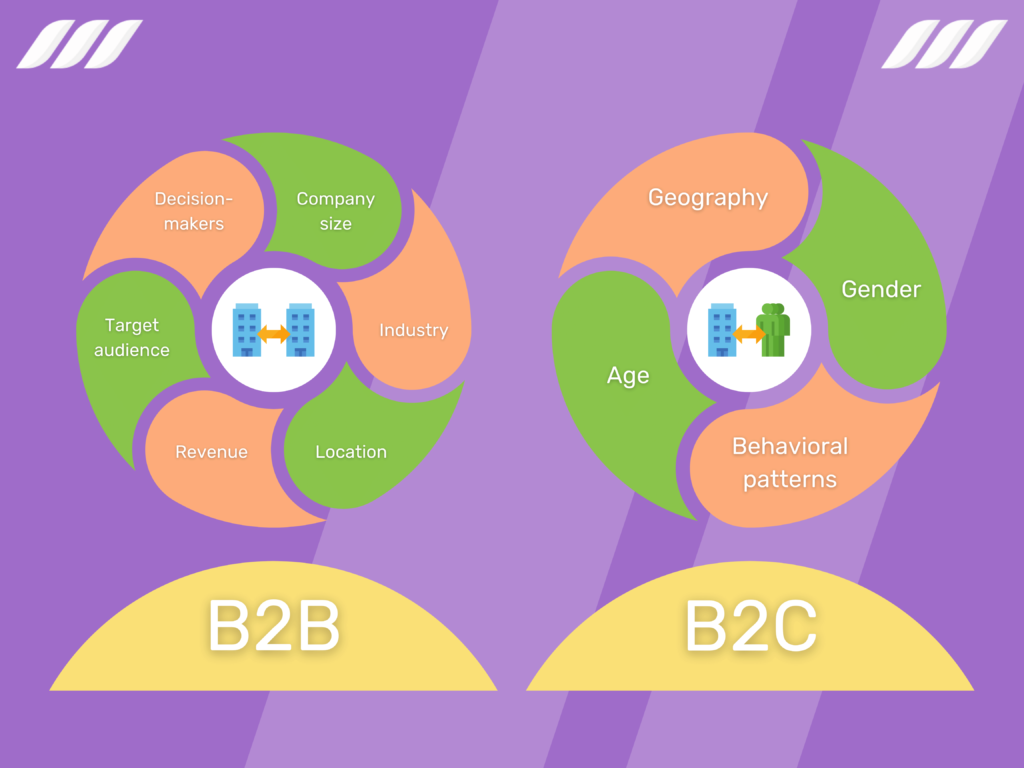
A customer profile describes your target customers’ buying patterns, demographics, and psychographics. In other words, it explores how your customers interact with your brand, their likes/dislikes, and the trends they follow.
A customer profile in the B2B context outlines your ideal ‘client company.’ Here we’re talking about details like company size, industry, location, revenue, target audience, and decision-makers.
By contrast, B2C customer profiles focus on individual customers. This time, data like age, gender, geography, and behavioral patterns come into play.

What Is an Ideal Customer Profile?
Ideal Customer Profile, also known as ideal buyer profile, defines the best customers for your product, service, or solution. This is done by mapping out the qualities of your ideal customers against what your company has to offer. The ones that hypothetically align with your products or services are profiled into your ideal buyers.
Why Create an Ideal Customer Profile (ICP)
Creating an ideal customer profile can save resources and time spent on sales and marketing. ICP provides a roadmap of who will buy your products/services. This way, you attract targeted leads worth driving through the sales funnel. Plus, it ensures you don’t waste your time and resources on prospects who aren’t likely to buy from you.
Finding Leads With LinkedIn Sales Navigator + Dripify


With paid LinkedIn accounts like LinkedIn Sales Navigator, you can overcome the limits on your search capabilities. This allows you to find and reach your target audience more efficiently.
But remember that a Sales Navigator account costs 100 USD per month. So, if you’re using multiple accounts for prospecting, it can cost you a lot of money.
Fortunately, there’s a way around it — a combo of Dripify and Sales Navigator.
The Dripify sales automation tool allows you to use a single Sales Navigator account to run multiple prospecting campaigns consecutively.
Let’s break it down into a stepwise process:
- Filter leads on LinkedIn using the Sales Navigator account.
- Push these filtered leads into Dripify, and create a simple sequence (view profile, for instance).
- Filter your leads by campaign, and export them as CSV.
- Use a free LinkedIn account to log into another Dripify account.
- Upload the CSV file and create a new campaign with those leads.
In a nutshell, Sales Navigator serves as your entry point to find leads and export them into CSV files using Dripify.
Related article: LinkedIn Account Types: Free vs. Premium vs. Sales Navigator
Ideal Customer Profile vs. Buyer Persona
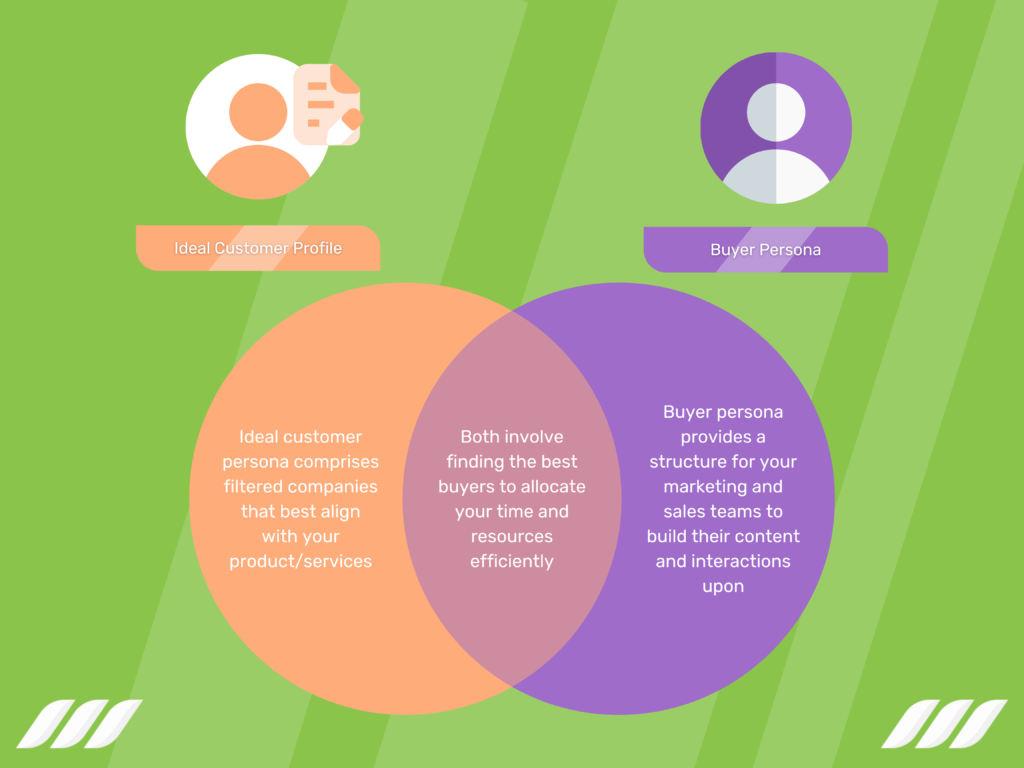

ICP and buyer persona are linked by the fact they both involve finding the best buyers to allocate your time and resources efficiently. But there do exist subtle differences in these concepts.
ICP comprises filtered companies that best align with your product/services. These are curated at the beginning of the sales funnel. The ICP is grounded in market research and analysis along the following domains:
- Budget/Revenue/Company Size
- Industry
- Geography
- Legality
- Product or Service Limitations
Once you’ve found your target companies, you probe into each one of them to define your buyer persona.
Buyer persona entails a semi-hypothetical, generalized description of customers regarding demographics, goals, motivators, and challenges. Basically, it provides a structure for your marketing and sales teams to build their content and interactions upon.
ICP and buyer persona work hand-in-hand to ensure your efforts are well-directed. ICP tells your organizations about the accounts they should be targeting. In comparison, a buyer persona guides your sales and marketing teams in creating the perfect experience for your buyers.


Why Is an ICP Important?
ICP lays the groundwork right from the beginning by finding qualified leads for businesses. It ensures your sales reps are not spending time on the wrong leads. The latter are the ones below your lowest cost threshold, out of your target locations, or those with mismatched verticals.
Creating an ICP is pivotal in ramping up your returns on investment and minimizing customer acquisition costs. Removing inappropriate customers ensures that your sales and marketing teams will focus on customers that would likely close.
More sophisticated ICP models rely on research data around techno-graphics, funding, IPO status, company size, etc. This ensures your company makes targeted investments on accounts that are most relevant.
Customer Profiling Benefits
Although customer profiling is directly related to sales teams, it can impact the entire operation of your business. Here are some reasons why customer profiling is a powerful business strategy:
1. Customer profile helps identify suitable prospects
Customer profiling narrows down your prospects, allowing you to find the most appropriate ones. By having customers with the exact needs you cater to, your close rate improves substantially. Besides, it is much easier to satisfy these customers than those loosely interested in your offerings.
2. Customer profiling decreases customer acquisition cost (CAC)
Customer acquisition cost (CAC) is the amount of money that organizations spend on sales and marketing to get their first customer. When you know your customers, you can spend your money more productively and cut down your CAC. For example, you get high click-through rates, more lead form submissions, better engagement levels, etc.
3. Customer profiling makes customer satisfaction easier
The first step to serving your customers is to know them as closely as possible. With customer profiling, you can tap into your customers’ pain points, wishes, characteristics, and behaviors. This way, you can ensure convenience at every step of the customer journey. For instance, you could anticipate potential challenges and have solutions lined up ahead of time.
4. Customer profile reduces the churn rate
Customer churn rate determines the rate of losing customers over time. Once you attract the right customers and you completely satisfy them with your products/services, the churn rate will go down automatically.
Ideal Customer Profile Framework
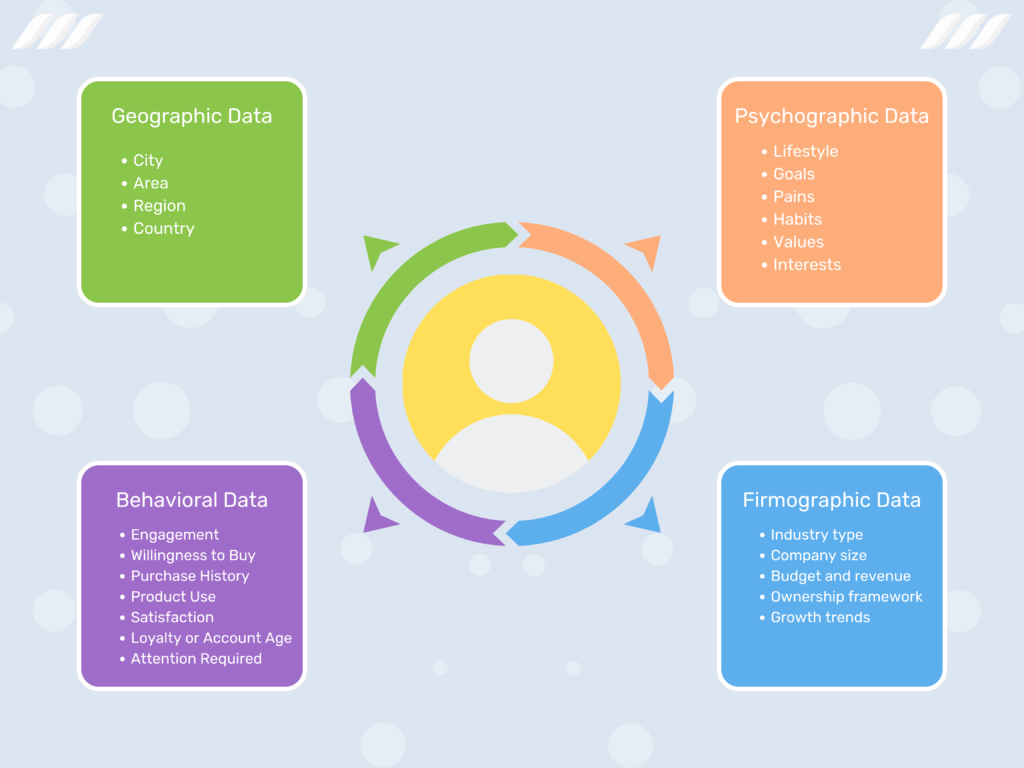

Creating an ideal customer profile is a multistage process, varying in terms of business nature and long-term or short-term objectives. Regardless, the following framework will serve as the skeleton of an ICP in any business scenario.
Geographic Data
Most businesses have now evolved and are technologically supported to serve all locations similarly. Despite that, different places would contribute to your sales differently. You can segment locations in terms of:
- City
- Area
- Region
- Country
You can better plan your logistics, support implementation, and marketing campaigns by factoring in geographic data.
Psychographic Data
Psychographic data can give you a deeper understanding of customers’ purchase decisions when coupled with demographics. These factors include psychological patterns and day-to-day dynamics such as:
- Lifestyle
- Goals
- Pains
- Habits
- Values
- Interests
Psychographic data is highly valuable in acquiring customers for your business. But that doesn’t stop there. These factors can help retain customers and even get them to purchase more. Once you know your clientele’s situation, you can bring more value, empathize better with their needs, set out purchase triggers, and more.
Behavioral Data
On the one hand, you have psychographic data that outlines the psychological characteristics of your potential customers. On the other, behavioral data speaks for what actions they could take and how they interact. This can be segmented into:
- Engagement
- Willingness to Buy
- Purchase History
- Product Use
- Satisfaction
- Loyalty or Account Age
- Attention Required
Firmographic Data
Firmographic data is the equivalent version of demographics when put into the context of companies. The non-exhaustive list of features consists of the following:
- Industry type – What industry do your potential customers belong to?
- Company size – How many units does the company have? What is the employee count?
- Budget and revenue – What annual budget does the company have? How much revenue does it generate? Can it meet your cost threshold?
- Ownership framework – Is this a private or public company?
- Growth trends? Are we dealing with an established business entity or a startup in the preliminary stages?
Ideal Customer Profile Examples
One of the examples below could perfectly serve as your ideal customer profile template. Make some tweaks based on your business scenario, and you’re good to go!
1. Scorecard
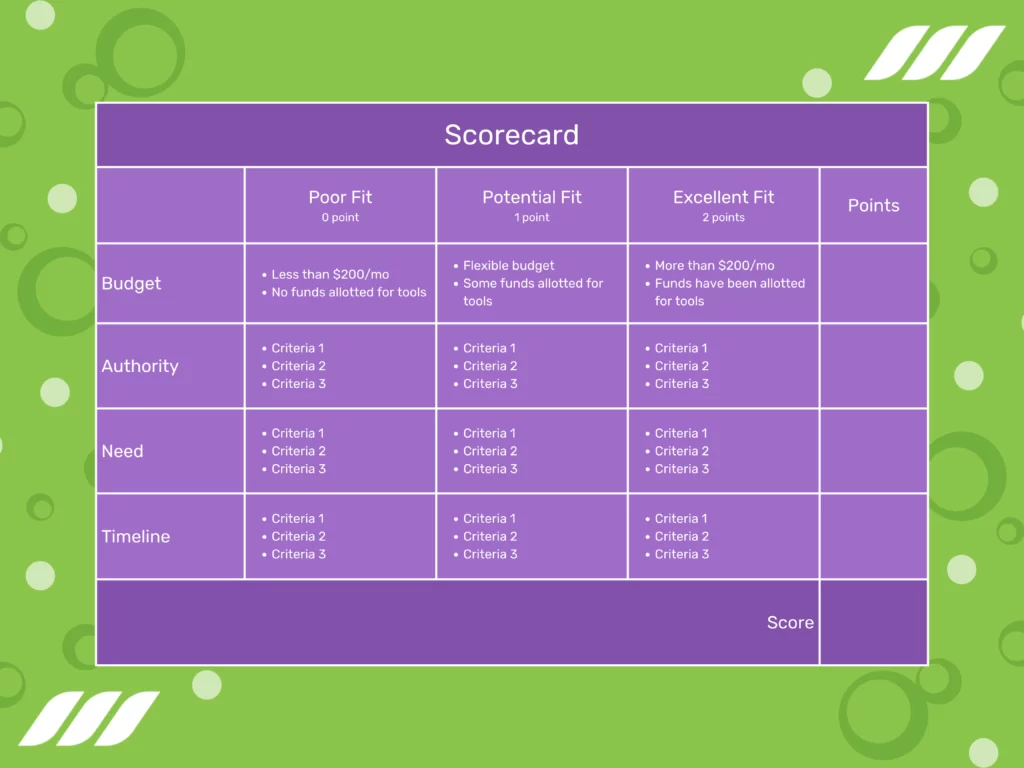

This customer profile example uses a BANT framework and a scorecard to rate how the company fits your business solutions. Once a company meets your desired score (from 0 to 2), it could be shortlisted for prospecting.
2. Segmentation
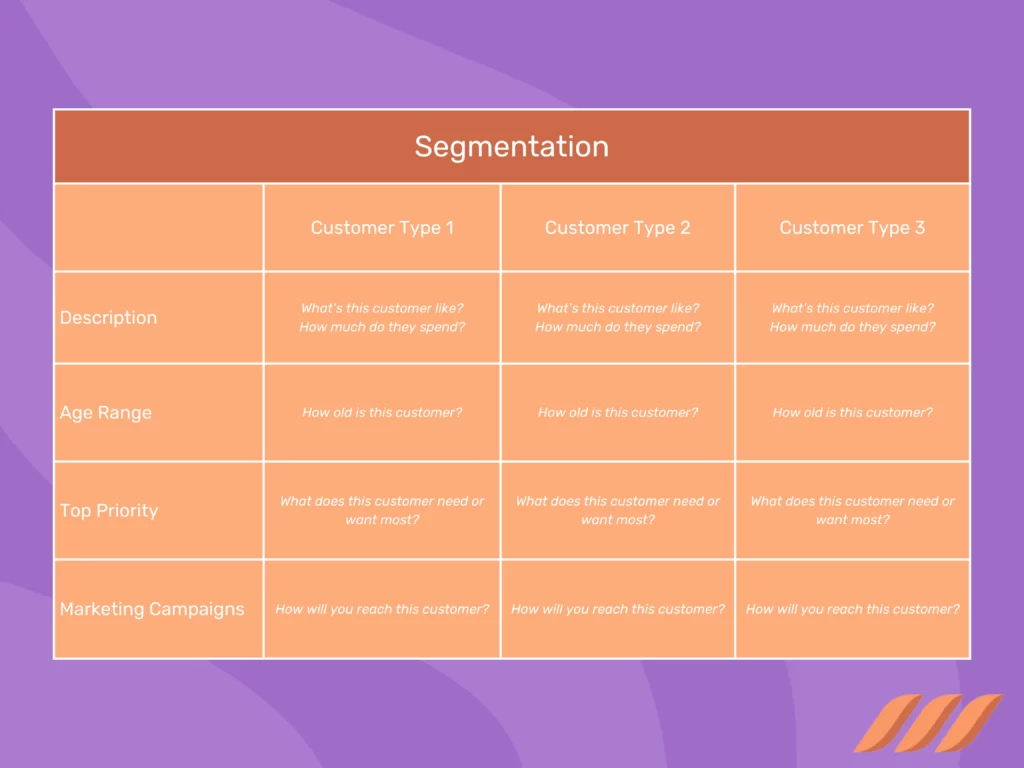

A segmentation approach subdivides prospects in terms of description, age range, top priority, and marketing campaign. With this information, your marketing teams can quickly employ the right ways and channels to initiate sales interaction with your potential buyers.
3. Basic Information
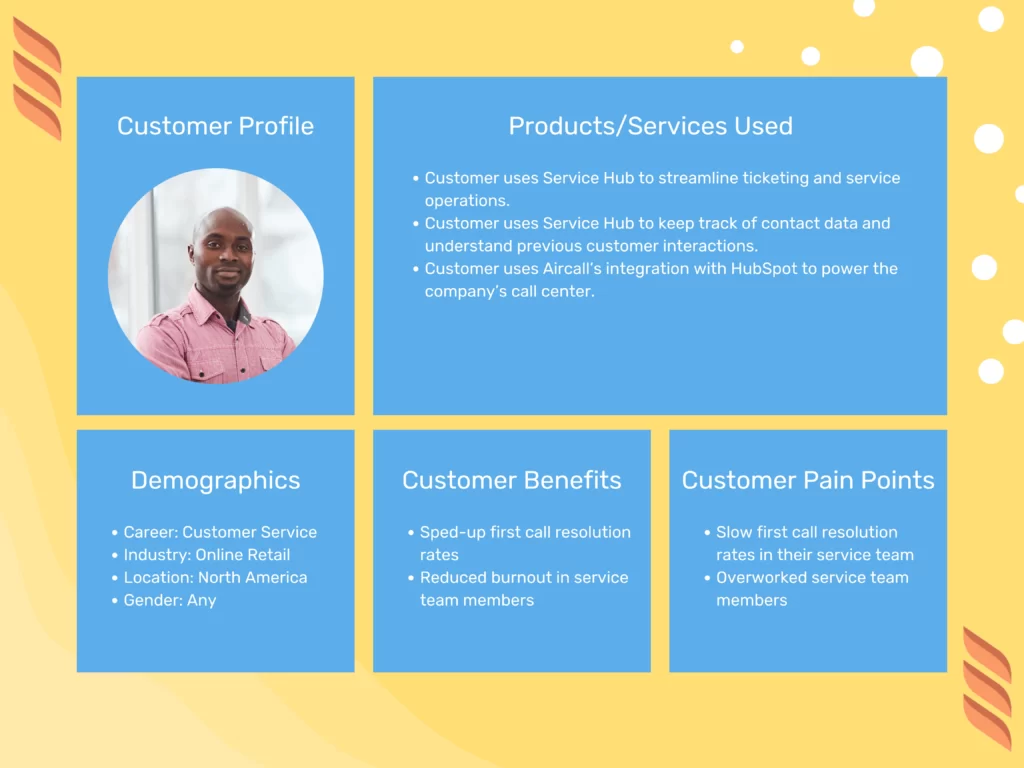

This ICP is another way to discover fundamental details about our target buyers. It comprises product/service history, demographics, customer story, customer benefits, and pain points. You can get straight to the point with this customer profile and uncover just enough information to know your target audience. You can tweak this format to make it your client profile template!
4. Profile With Abilities


In this customer profile example, five elements are used to narrow down your ideal customers:
Need – Does your prospect’s problems coordinate with your solutions?
Time – Can you provide your solution within the deadline?
Success – Has the prospect previously purchased your solutions? How was the experience?
Budget – Do they have the budget and buffer for your solutions?
Winners – Do decision makers/influencers ultimately gain benefit?
How to Create an Ideal Customer Profile?
Let’s have a look at the major steps to creating an ideal customer profile.
Focus on your best solutions and best customers
Before anything else, creating an ICP depends on whether you’re starting a business or looking to grow your current business.
If you’re just starting out, bring your attention to the problems your products can solve and the customers facing those problems. You can use the GRASP model to segment your potential customers:
Growing – your target company should be receptive to growth decisions — e.g., upskilling.
Ready – It should be on the lookout for solutions like yours.
Able – It should be able to afford your products or services.
Skilled – It should be skilled enough to recognize your solutions as a potential fit for their problems.
Profit-gaining – This trait evidences that you can increase profitability for your potential customer.
In contrast, if you already have customers, your focal point should be your happiest customers. These are the ones who:
- constitute the biggest portion of your revenue.
- have the shortest sales cycle.
- are most satisfied doing business with you.
- have stayed with your company the longest.
Track your best customers
By mapping out your happy customers, you can predict who could be your ideal customers. You can filter out your best customers with the following attributes:
- Industry segment
- Location
- Company size
- Company budget
- Years of being active
- Details about decision-makers
- Needs and pain points
Collect customer feedback
Tracking your best customers is a good starting point. But, you can reinforce your findings and get more details by having a firsthand account of your existing customers.
This can be done by setting up phone calls, video calls, or surveys. The goal is to investigate why your loyal customers buy your solutions, what areas you could improve upon, etc.
Consider these questions when conducting the feedback:
- How long do you research before making your purchase?
- Do you prefer having referrals when looking for solutions?
- Who are the key decision-makers in your company?
- What are the winning aspects of our products/services?
- What made you stick with us for so long?
Analyze your customer journey map
A customer journey map showcases all the stages customers go through before committing to purchase from you. When done correctly, it can reveal the following:
- The socio-economic factors that drive their purchase decisions.
- Their obstacles in completing a purchase with you.
- How big their team is.
- What challenges they’re facing, and how can you ease them off?
- How seamlessly they’re communicating with your organization.
- How do they assess their problem?
Once you contextualize these details, the next step is to see if you can live up to your prospects’ expectations. For that, ask yourself these questions:
- Can you provide value to these customers?
- Can you solve their pain points?
- What are the features that set you apart from the competition?
- How can your business help them achieve short- and long-term goals?
Understand your industry
Understanding your customers is a crucial element of customer profiling. But, introspecting your industry is equally important. In particular, you should know where you stand compared to your competitors, who your top competitors are, and what long-term goals you’re shooting for.
Understanding your industry is vital for having a big picture of your ideal customers. Besides, it defines your brand identity and suggests how you can differentiate your products and services.
Build buyer persona
Now that you have your target companies with you, it’s time to delve into the key decision-makers inside those organizations. Here are a few things you can discover about the key decision makers and influencers within each account:
- Title
- Age bracket
- Education level
- Income scale
- Where can you reach out to them?
- What key responsibilities do they have?
- How do they contribute to the decision-making process?



Conclusion
Customer profiling is an invaluable strategy for your business growth. It can set the stage for your business activities by defining what features to build upon, what marketing channels to use, how to improve your services, how to guide your customer’s decision-making process, etc.
Without an Ideal Customer Profile, you either risk proposing the wrong solutions for your prospects or finding the wrong prospects for your products or services. Your ICP will help you find companies or individuals genuinely looking for your product or service. This will ultimately super-charge your sales and revenues, besides reducing your marketing costs.
As you create a customer profile, use your existing customers for key insights, contextualize details about your prospects, map out the customer journey, know clearly how you can add value, and build a buyer persona to build relationships with decision-makers.

![How to Write a Price Increase Letter [Tips, Examples, and Free Template]](https://dripify.io/wp-content/uploads/2021/12/27.png)
![How to Write an Effective Collaboration Email [+Templates]](https://dripify.io/wp-content/uploads/2023/05/13.png)



